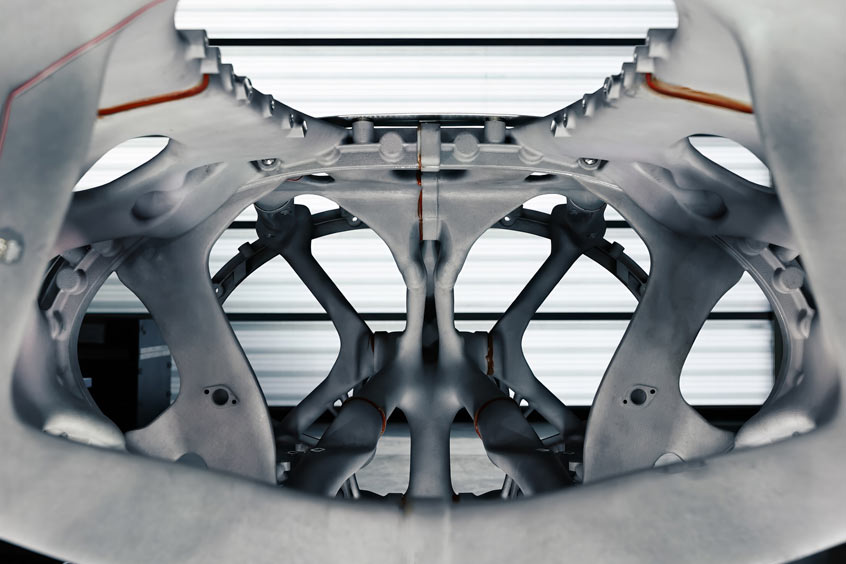PRESS RELEASE
Issued by: Hexagon Manufacturing Intelligence
Hexagon's Manufacturing Intelligence division and Stratasys, a leader in polymer 3D printing solutions, have applied Hexagon's simulation technology to capture the behaviour of Stratasys' high-performance, ultra-lightweight Antero™ reinforced polyetherketoneketone (PEKK) materials and its additive manufacturing processes. These rigorously validated simulations offer Stratasys customers unique insight so they can lightweight components and introduce new sustainable aircraft and spacecraft faster.
3D printed plastic parts offer transformative lightweighting for aerospace, reducing the energy use and increasing the range of new aircraft. When the material and processes are fully exploited by product designers, it may also reduce the cost caused by overengineering and the waste and lead times of traditional manufacturing. However, the adoption of plastics and additive methods for structural components has remained slow due to the industry's safety-critical nature and regulations. Providing engineering teams the simulation tools to validate that these materials will achieve the required part performance when manufactured is the "missing link", enabling designers to apply these breakthroughs today.
Rigorously-validated multi-scale models of these new high-performance aerospace-approved materials — Stratasys Antero 840CN03 and Antero 800NA — have now been added to Hexagon's Digimat materials exchange ecosystem, with associated print process parameters from Stratasys' aerospace-ready 3D printers. Using these detailed proprietary models, engineers can create digital twins that accurately predict how parts printed with the chosen material and approved aerospace-ready Stratasys printer will perform in a digital reality with real-world use cases and certification tests before any physical prototypes are manufactured.
Developed to be open, Digimat software gives manufacturers the ability to design lighter parts that can match metals in performance and avoid costly overengineering using their preferred finite element analysis (FEA) and computer-aided engineering (CAE) tools. Moreover, companies that use Digimat in conjunction with Hexagon's MSC Nastran and MSC Apex will accelerate the certification and documentation of their work.
The Antero™ materials are already being used at the cutting edge of aerospace engineering, bringing major innovations to reality on time, such as Lockheed Martin using Antero 840CN03 to create NASA's Orion spacecraft docking hatch cover. By making rigorous digital engineering and virtual manufacturing possible with these new simulation tools, more product development teams can apply and de-risk Stratasys' aerospace additive manufacturing solutions.
Aziz Tahiri, vice president of global aerospace and defence for Hexagon's Manufacturing Intelligence division, said: "As the aerospace industry continues to push for more sustainable designs, unlocking the lightweighting potential of thermoplastics and 3D printing will be key. By leveraging the power of our simulation technology, manufacturers gain access to proprietary information so their engineers can 'work the problem' with reliable information. We're excited to see how this next chapter with Stratasys will help the industry create lighter, stronger designs in any design engineering tool with more confidence and less cost and help bring next-gen aircraft to market faster."
Foster Ferguson, aerospace business segment leader, Stratasys, said: "The Antero 840CN03 and Antero 800NA thermoplastics provide unprecedented strength, heat, and chemical resistance. When combined with Hexagon's simulation insights and actionable data, these 3D printed materials' ability to replace certain applications of aluminium and steel clearly points to growing use in the aerospace industry. We believe they meet manufacturers' increasingly complex performance needs, and by combining innovative modelling software with 3D printing, can reduce production timelines from months to days."
Through the partnership between Stratasys and Hexagon, which has spanned more than a decade, several high-performance thermoplastic materials — including Ultem™ 9085, Ultem 9085 CG, Ultem™ 1010, and Nylon12CF — have been characterised and added to Hexagon's Digimat material modelling software.
| Contact details from our directory: | |
| Hexagon Manufacturing Intelligence | UAV Control Software, Flight Management Systems |
| Stratasys Ltd | Injection Moulding, Models, Machining Systems, Additive Manufacturing (Resin) |
| Related directory sectors: |
| Plastic Processes |
| Machining |
| Flight and Data Management |
Weekly news by email:
See the latest Bulletin, and sign up free‑of‑charge for future editions.

Saab advances digital manufacturing with autonomous fuselage

Airbus deploys Stratasys printed parts for A320, A350 and A400M

Electra kicks off Part 23 application for hybrid-electric EL9
